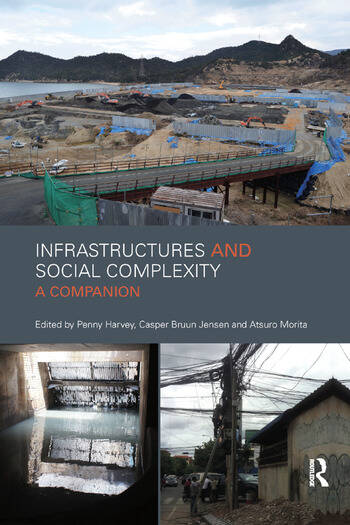Harvey, P., Jensen, C. B., & Morita, A. (Eds.). (2019). Infrastructures and social complexity: A companion (1st ed., pp. 1–442). Routledge. (Original work published 2017)

Infrastructures and Social Complexity: A Companion is an edited collection aimed at understanding the complexities of building infrastructures. The collection first explores how infrastructure mediates cities’ battles with controlling nature: “…we need to see the earth, its rocks, soil and water, as integral to the ongoing existence of infrastructure” (p. 187). On the other hand, sometimes the problem comes from us rather than nature. In society the population is often divided into two groups. First, there is “…a denial of consumption’s fallout – waste’s management encourages us to forget in order to recommit our sins – and a hopeful, if naïve, rebirthing as our buried discards are resurrected for profit” (p. 243). In other words, many ignore the harm we are causing in doing so, and continuing to engage in these activities aggravates the issue. In contrast, our “concern with climate change, in particular, animates a range of urban infrastructural interventions to achieve (so-called) low-carbon and resilient cities” (p. 103). Therefore, there is a constant conflict and debate between those who admire the city and those who see further development of cities as harmful to the environment.

The idea of developing digital infrastructure is a major focus of this book. Digital infrastructure was developed as a solution to this dilemma: “Digital infrastructures are reshaping approaches to, and understandings of data, information and infrastructure themselves” (p. 335). ‘Smart City’ or digital infrastructure solutions include “[s]mart Motorways, computer-controlled air and rail systems, and the myriad devices that track, map and monitor environments, movements, and bodies shape how we interact with each other and with the world” (p. 335). This begs the question of whether digital infrastructures are our most viable option?
Even though this book presents some very interesting points and keeps the reader engaged, one challenging topic to grasp was the description of households. In chapter 24, “Survivals as infrastructure: Twenty-first-century struggles with household and family in formal computations” (p. 323) the family-household model (p. 326) is defined as “a taxation unit, dependency within the household, the consumer price index: ‘shared resources’, findings on the ‘house = asset’ aspect of the ‘household’” (pp. 326-331). Although defining households as units of taxation is not new, it is a specific and limited way to define a household or ‘family’.
Overall, this book was captivating and would really stand out to those interested in creating a digital world such as the metaverse: a virtual reality or digital world where people can interact. Work meetings, exploring cities, and so on, will allegedly occur in the comfort of our own home through the metaverse. Those who aspire to operate in virtual realities and understand a metaverse as a potential social infrastructure will find this book worthwhile.
- Zarvan Patel
